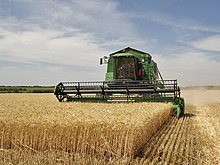– Etymology:
– Harvest originated from Old English “hærf-est,” meaning autumn or harvest-time.
– The term expanded to include the activity of reaping and gathering crops.
– To harvest is to reap, gather, and store crops.
– Harvesters are individuals or equipment involved in harvesting.
– Harvesting marks the end of the growing season and is celebrated in many cultures.
– Crop failure:
– Crop failure results in diminished yields due to plant damage or environmental factors.
– Causes include plant diseases, volcanic eruptions, storms, and soil degradation.
– Historical crop failures have led to famines and human migration.
– Industrial monocultures and overexploitation contribute to soil degradation.
– Sustainable farming practices are crucial to prevent crop failures.
– Other uses:
– Harvesting extends beyond crops to include fishing, logging, and grape harvesting.
– Wild harvesting involves collecting uncultivated plants.
– Water harvesting collects rainwater for various uses.
– Energy harvesting captures and stores renewable energy sources.
– Body harvesting involves collecting cadavers for study or organ transplant.
– Canada:
– Harvesting in Canada refers to hunting, fishing, and plant gathering by indigenous communities.
– First Nations, Métis, and Inuit have harvesting rights under various agreements.
– Harvesting includes hunting, trapping, fishing, and gathering plants or trees.
– Gallery:
– Images of harvesting activities in different regions and time periods are showcased.
– Maize, rye, sugar beet, and rice harvesting are depicted.
– Visual representations of harvesting practices offer insights into agricultural traditions.
This article needs additional citations for verification. (May 2008) |
Harvesting is the process of collecting plants, animals, or fish (as well as fungi) as food, especially the process of gathering mature crops, and "the harvest" also refers to the collected crops. Reaping is the cutting of grain or pulses for harvest, typically using a scythe, sickle, or reaper. On smaller farms with minimal mechanization, harvesting is the most labor-intensive activity of the growing season. On large mechanized farms, harvesting uses farm machinery, such as the combine harvester. Automation has increased the efficiency of both the seeding and harvesting processes. Specialized harvesting equipment, using conveyor belts for gentle gripping and mass transport, replaces the manual task of removing each seedling by hand. The term "harvesting" in general usage may include immediate postharvest handling, including cleaning, sorting, packing, and cooling.


The completion of harvesting marks the end of the growing season, or the growing cycle for a particular crop, and the social importance of this event makes it the focus of seasonal celebrations such as harvest festivals, found in many cultures and religions.
